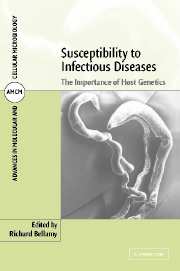Book contents
- Frontmatter
- Contents
- Contributors
- 1 Introduction
- 2 Application of genetic epidemiology to dissecting host susceptibility/resistance to infection illustrated with the study of common mycobacterial infections
- 3 The diverse genetic basis of immunodeficiencies
- 4 Genetic diversity in the major histocompatibility complex and the immune response to infectious diseases
- 5 The cystic fibrosis transmembrane conductance regulator
- 6 The influence of inherited traits on malaria infection
- 7 Polymorphic chemokine receptor and ligand genes in HIV infection
- 8 NRAMP 1 and resistance to intracellular pathogens
- 9 The interleukin-12/interferon-γ loop is required for protective immunity to experimental and natural infections by Mycobacterium
- 10 Mannose-binding lectin deficiency and susceptibility to infectious disease
- 11 Blood group phenotypes and infectious diseases
- 12 Genetics of human susceptibility to infection and hepatic disease caused by schistosomes
- 13 Genetic susceptibility to prion diseases
- Index
- Plate section
5 - The cystic fibrosis transmembrane conductance regulator
Published online by Cambridge University Press: 14 August 2009
- Frontmatter
- Contents
- Contributors
- 1 Introduction
- 2 Application of genetic epidemiology to dissecting host susceptibility/resistance to infection illustrated with the study of common mycobacterial infections
- 3 The diverse genetic basis of immunodeficiencies
- 4 Genetic diversity in the major histocompatibility complex and the immune response to infectious diseases
- 5 The cystic fibrosis transmembrane conductance regulator
- 6 The influence of inherited traits on malaria infection
- 7 Polymorphic chemokine receptor and ligand genes in HIV infection
- 8 NRAMP 1 and resistance to intracellular pathogens
- 9 The interleukin-12/interferon-γ loop is required for protective immunity to experimental and natural infections by Mycobacterium
- 10 Mannose-binding lectin deficiency and susceptibility to infectious disease
- 11 Blood group phenotypes and infectious diseases
- 12 Genetics of human susceptibility to infection and hepatic disease caused by schistosomes
- 13 Genetic susceptibility to prion diseases
- Index
- Plate section
Summary
INTRODUCTION
Cystic fibrosis (CF) patients suffer from persistent airway infections. A hallmark of CF lung disease is chronic infection, initially with Staphylococcus aureus or Haemophilus influenzae and subsequently with Pseudomonas aeruginosa and Burkholderia cepacia, in which host defence mechanisms become overwhelmed. Infection is followed by a neutrophil-dominated inflammatory response due to exotoxins released by the bacteria together with enzymes, such as elastase, cathepsin G, and proteinase-3, and release of inflammatory mediators, such as IL8. The latter acts as a powerful neutrophil attractant. Increased mucin formation by the epithelial cells also occurs but does not seem to be a consequence of bacterial infection, as it is found in the airways of CF foetuses (Ornoy et al., 1987). The continual tissue damage and fibrotic changes following infection lead to a gradual loss of lung function, the major cause of morbidity and mortality in this genetic disease.
Curiously, as we shall see later, CF can protect individuals from other types of infectious disease. Also, heterozygotes, carrying a faulty CF gene on one allele, are considered to be entirely normal and the persistence of the gene in the population has led to suggestions that there may be an heterozygote advantage in carriers. However, recent evidence suggests that heterozygotes are more susceptible to sinusitis and chronic rhinitis than noncarriers (Wang et al., 2000). Evidence will also be presented that suggests that heterozygotes are less susceptible to a number of bacterial diseases affecting the gut.
- Type
- Chapter
- Information
- Susceptibility to Infectious DiseasesThe Importance of Host Genetics, pp. 117 - 138Publisher: Cambridge University PressPrint publication year: 2003
- 1
- Cited by



